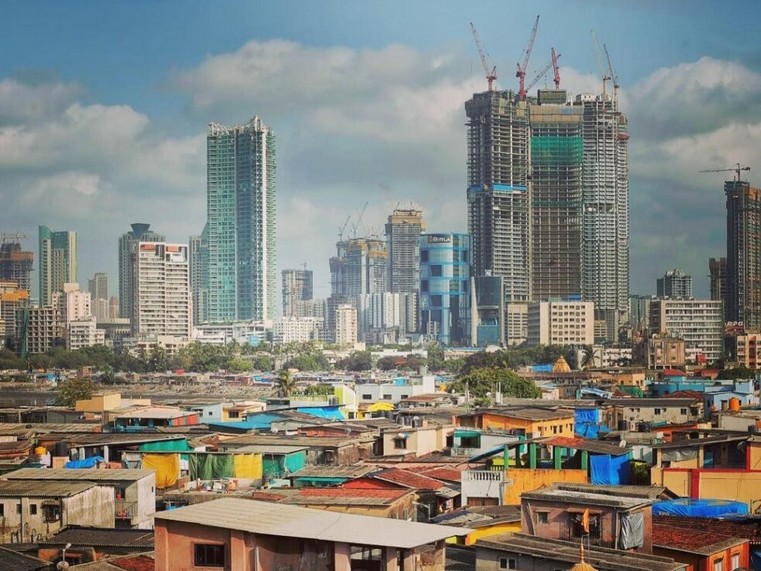| Smash 2025 FLT 09: Q10. While cities are engines of growth, they are also spaces of exclusion. Discuss how rapid urbanisation has contributed to rising socio-economic inequalities in Indian cities. |
| PYQ: Q. What are the main socio-economic implications arising out of the development of IT industries in major cities of India? (2021) |
As per Census 2011, India’s urban population was 377 million (31%), and NITI Aayog projects it will rise to 40% by 2030 and 50% by 2047.
| Fact File: As per World Bank Poverty & Equity Brief, extreme poverty in urban centres reduced from 10.7% (2011-12) to 1.1% (2022-23). |
Issues of Urban Poverty and Distributive Justice in India
- Slums & Housing Shortage – 65M+ in slums without tenure or sanitation. (17% Urban Population living in slums)
- Informal Work – 80%+ urban workers in insecure, low-wage jobs.
- Basic Services Gap – Unequal access to water, power, sanitation.
- Digital Divide – Poor excluded from ICT-based governance.
- Healthcare Inequality – Overcrowded, costly, limited insurance.
- Educational Exclusion – Low quality, high dropout, digital gap.
- Gender Disparities – Unsafe mobility, wage gaps, care burden.
- Environmental Risks – more vulnerability to urban heat island, floods etc
- High Cost of Living due to rising inflation
Role of Smart Cities in Addressing Poverty
- Affordable Housing & Slum Redevelopment through PMAY (Urban) projects. Eg– affordable rental housing complexes in Bhubaneswar Smart City
- Skill Development & Livelihood Creation – Linking smart city projects with National Urban Livelihood Mission (NULM) for skilling, self-employment, and start-ups. Eg– Pune Smart City created skill hubs for IT and service sector jobs.
- Support for Informal Economy – Eg– Indore Smart City earmarked vending zones under Street Vendors Act 2014.
- Improved Basic Services – Smart water meters, 24×7 water supply pilots, universal solid waste collection. Eg- Ahmedabad Smart City’s sensor-based water monitoring saved 50 MLD/day
- Urban Health Access – Digital health kiosks, smart health cards, and e-medicine platforms improving access for slum residents and migrants. Eg– Surat Smart City e-health cards for migrant workers.
- Education Access – Eg– Pune and Bhopal Smart Cities equipped municipal schools with digital boards and online learning tools.
Role of Smart Cities Ensuring Distributive Justice
- Inclusive Governance & Citizen Engagement – Participatory platforms (apps, consultations, ward-level meetings) to integrate voices of marginalized groups. Eg– Bhubaneswar Smart City’s “My City My Pride” consultations.
- Digital Inclusion – Free Wi-Fi zones, community digital kiosks, e-service centres in underserved localities bridging the digital divide.
- Equitable Service Delivery – Targeting universal coverage in water, sanitation, electricity, and waste collection for both elite and informal areas.
- Transit-Oriented Development – Affordable, accessible public transport (BRTS, e-buses, cycle-sharing) linking poor workers to jobs. Eg- Bhubaneswar’s multi-modal railway hub & hi-tech traffic system.
- Environmental Justice – Eg– Indore Smart City’s sewage treatment prevented 205 MLD waste from polluting rivers
- Gender Justice in Urban Spaces – Smart street lighting, CCTV surveillance, and safe public transport initiatives improve safety for women.
- Renewable energy – Eg- Visakhapatnam’s floating solar plant saved $0.28M annually and 3,000+ tons CO₂; Indore’s 100% waste segregation included slums.
| Key Challenges | Way Forward |
| Limited Coverage – 80% funds in Area-Based Development covering only 3–5% of cities, excluding majority. | Scale projects to underserved and peri-urban areas for inclusivity. |
| Project Delays – Many projects saw 2–3 year delays and cost overruns up to 40% despite 94% completion (2025). | Timely Execution – Strengthen monitoring, streamline clearances, and adopt PPP models. |
| Weak ULB Capacity – Only 25% ULBs have trained planners, limiting efficiency and innovation. | Strengthen ULBs – Train municipal staff, deploy urban planners, and enhance autonomy. |
| Lack of Sustainability Focus – Only 35% cities integrate green or climate resilience measures (MoHUA). | Mainstream Climate Action – Mandate resilience plans, promote green buildings & clean mobility. |
| Low Citizen Participation – Weak community engagement in planning and monitoring. | Enhance Public Participation – Use ICT platforms for citizen feedback and accountability. |
As John Rawls argued, justice demands prioritizing the least advantaged first (difference principle)—a principle that should guide India’s smart urban transformation.
With principles of equity, sustainability, and inclusion, Smart Cities can evolve into “just cities” of the 21st century—where growth and justice move hand in hand.
Component based approach
Poverty
- Income deprivation
- Unemployment and underemployment
- Lack of basic needs
- Educational deprivation
- Health deprivation
- Social exclusion and marginalization
- Lack of access to assets
- Vulnerability to shocks
- Intergenerational transmission
Distributive Justice
- Equality – Fair treatment without discrimination.
- Equity – Distribution based on needs and circumstances.
- Desert (Merit/Contribution) – Allocation according to effort or performance.
- Need – Priority to the disadvantaged and vulnerable.
- Rights & Entitlements – Guarantee of basic minimum rights for all.
- Opportunity – Equal access to resources and avenues for advancement.
- Utility/Well-being – Maximising collective welfare of society.
- Sustainability – Justice extended to future generations in resource distribution.


